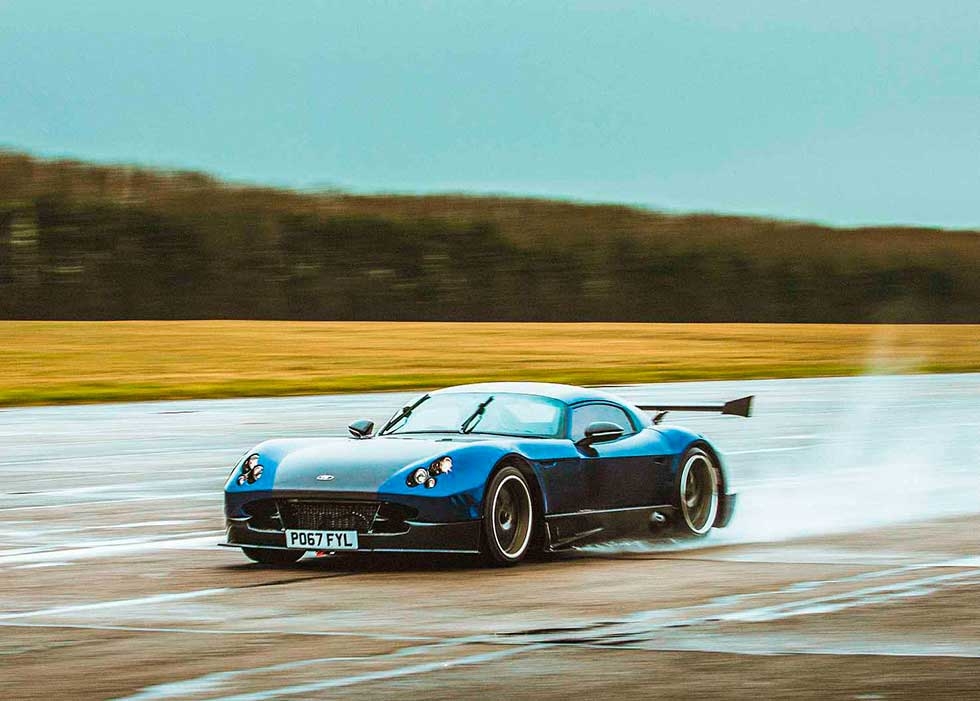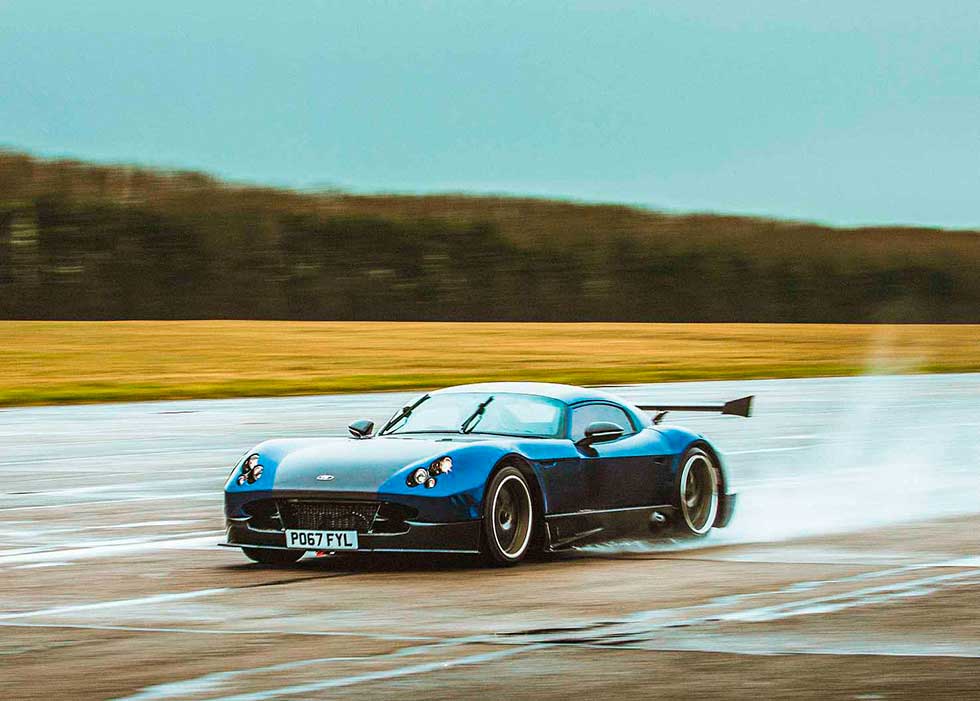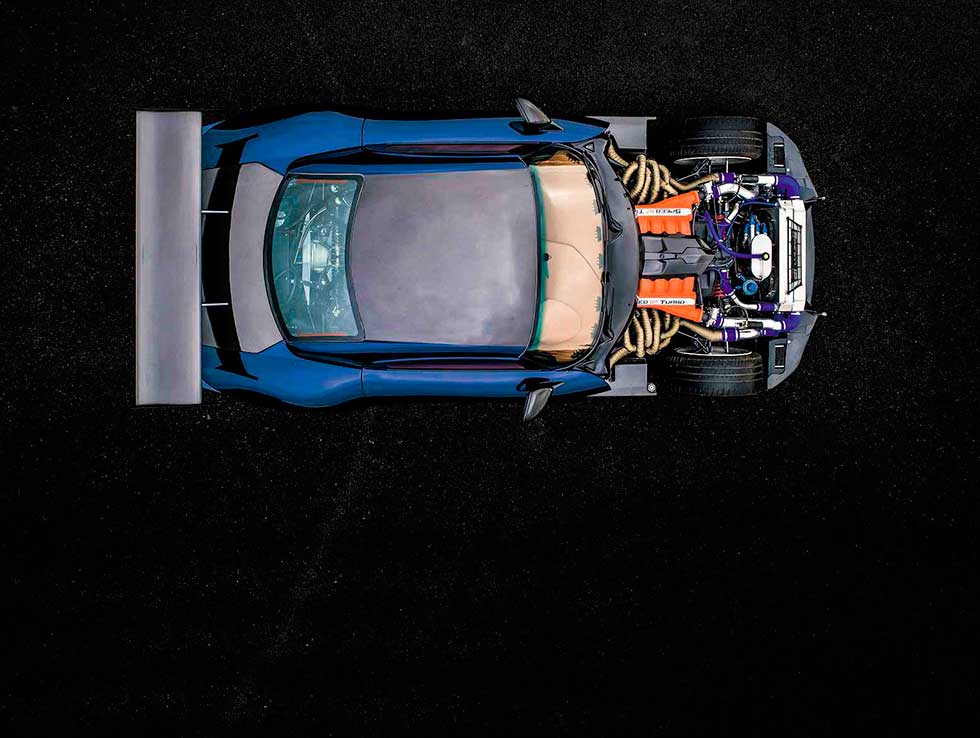
TVR speed 12. The spirit of TVR’s Cerbera Speed 12 has been reborn, and it’s even more extreme than before. Words and photos by David Vivian.
NEED FOR SPEED 12
‘THE SPEED 12 T IS OLDSCHOOL. ANALOGUE. AWESOME’
The biggest, baddest TVR of them all is back! Resurrected by a small band of former TVR employees, the original hypercar is returning to limited production. David Vivian visits the home of the new turbocharged Speed 12 before getting behind the wheel of the 1000bhp-plus, rear-wheel-drive machine that will give today’s new breed of hybrid hypercars nightmares.

It’s the car that snapped the input shaft of a 1000bhp-rated dyno. The car with acceleration so monumental that Drive-My’s John Barker summed it up in one word: terrifying. The car harddriving, weekend-racing TVR boss Peter Wheeler backed out of after taking it home for the night, declaring it ‘too wild and powerful for the road’.
‘£1.2M IS A LOT OF DOUGH, SO COMPREHENSIVELY BETTER AND A GOOD DEAL FASTER ARE GIVENS’
Put simply, back in the late ’90s, the TVR Cerbera Speed 12 was too fast to live. Even though Project 7/12’s development brief was heavily biased towards creating a GT1 endurance racer, with the aim of competing at Le Mans, a naturally aspirated 7.7-litre V12 developing nearly 900bhp in a road car weighing just 1100kg must have seemed looney tunes with knobs on. Even so, word on the street was this might just be the car to plant one on the ‘untouchable’ McLaren F1.
After Wheeler’s drive-home epiphany, the big, bad TVR tanked as a proposition for the road before the rivalry could become a reality. This, ironically, just as the nascent ambition to kick over the 240mph McLaren’s supposed ‘line in the sand’ was leading to the Bugatti Veyron-to-Chiron’s 250-270mph targets for the likes of Koenigsegg, SSC and Hennessey to shoot at. Too fast to live? Maybe. But 20 years on, with outer limits routinely scoped by circa 1000bhp hypercars, was the Cerbera Speed 12 too young to die?

Six end-game TVR employees in Blackpool – many with Speed 12 form and one, crucially, a ‘workie’ named Ben – were haunted by the belief that it was and, as evidenced by the subsequent escalation of power and speed, that the timing of its demise was pretty lousy. But then, even with a Lamborghini-loving Russian at the helm for TVR’s happy hour in the last chance saloon, the Speed 12 was probably always doomed to an afterlife of myth and what if.
‘HALF -THROTTLE IS ENOUGH TO SEND THE CAR HURTLING DOWN THE AIRSTRIP AT A LAZY 180MPH’
Ah, young Ben. Ben Morris. Eldest son of Charles Morris, MD, engineering director and joint owner of Helical Technology, a Lancashire-based engineering business with a family lineage reaching back to the ’60s. Today it designs and makes turbo actuators, valve rotators, exhaust valves and prototype exhaust systems, among other cutting-edge solutions, for the automotive industry. Clients include JLR and Aston Martin, and operations are ongoing in China and India.
To cut a long story short, Ben tapped up his dad. Next thing, ‘what if?’ dramatically flipped to ‘like this’. If the Cerbera Speed 12 hasn’t exactly been exhumed from the grave, its spirit is being revived with a Dyson high-tech cooling fan and a bottle of eye-swivelling smelling salts, Helical’s estimable and relevant engineering chops on the table for the run through to the first 1012bhp, 218mph+ TBR Cars Speed 12 Turbo. It’s being delivered to its owner this December in exchange for £1.2million, and is known as car number three.
Rewind to car one – an almost indistinguishable tangerine orange repro-cum-testbed revival of Wheeler’s Speed 12 but with an Aston-based 5.9-litre V12 – and it’s the gateway to a kind of weird, twisted, messed-up Avengers Assemble deal. Key talents and disciplines emerge from the ashes of old TVR and are marshalled by high-tech organisation Helical. Their mission: to save the world from deftly digital, seamlessly slick and shinily efficient cars such as the McLaren 720S and Tony Stark’s endless succession of Audi R8s by summoning the dark, ancient and irresistible power of Thanos. Well, something like that. Point is, the Speed 12 Turbo isn’t slick and shiny. It’s the antidote, an automotive expression of might and menace. Old school. Analogue. Awesome.
And, thanks to the select group of people involved, made with real TVR DNA. Team manager and chief mechanic Mike Vernon was a head technician at TVR for ten years. Design, development and CAD engineering is the responsibility of Tom Blount, 11 years with TVR and its CAD department head. Darren Hobbs and Chris Stallard worked together at the Blackpool factory, Chris as a designer, Darren his boss, heading up design and development – 13 years of TVR experience between them. Here they’re driving the S12T’s styling and composites engineering. And, finally, contract engine specialist John Ravenscroft, head of TVR’s powertrain department for 25 years and the man who developed what was essentially two Al Melling-designed Cerbera Speed Six straight-sixes spliced together with a steel block into a viable, dyno-eating 7.7-litre V12. Project enablers Charles Morris and son Ben from Helical are joined by programme manager Conrad Passmore who is also the specialist behind the car’s high content of 3D-printed components, including the mother of all feel-good gearknobs.
Car two, finished in black carbonfibre and navy blue and made ground-up from Helical’s original CAD model and moulds, is the workhorse prototype, the Speed 12 Turbo as it will be. And, for that, read ‘inspired by’ the original Cerbera Speed 12 and not a faithful nut and bolt copy. The subtext here isn’t hard to decipher: £1.2million is an awful lot of dough so, apart from the bad-ass shape and rarity value, comprehensively better and a good deal faster aren’t goals, but givens. Just the thought makes me shudder.
The sight of the Speed 12 Turbo up close and personal (that wing!) makes me shudder again. It’s a rainy day at the Bruntingthorpe Proving Ground, all the avengers are assembled, eating sandwiches, and under the pretext of some high-end engine mapping and precision apex thrapping, Thanos is waiting and ready to rumble. It should be something to behold. With an aluminium honeycomb composite cockpit structure, a modular tubular-steel chassis/cage, fully adjustable rose-jointed suspension, carbonfibre bodywork, centre-lock wheels, carbon-ceramic brakes and a titanium exhaust system, the original Speed 12’s racing roots are honoured but brought right up to date and fused with greater day-to-day usability and an interior that makes the most ‘out there’ TVR cabins of yore look demure. And all this before the myriad layers of bespoke-ness most customers are likely to order have been applied. This undertaking isn’t being shrugged off, hence the projected production rate of just two to three cars a year.
Continuing with the monstrous, dirty (but nevertheless gloriously nuts) 7.7-litre V12 was never a realistic option, but the repurposed AML 5.9-litre V12, fed by a brace of BorgWarner turbos (with Helical actuators, natch) and with uprated pistons, rods, crank and so on by Helical’s engine team, is a worthy substitute. Peak power of 1012bhp happens at 6700rpm, supported by a relatively modest 615lb ft of torque at a surprisingly high 7000rpm, but with a remarkably free-revving 8750rpm red line for such a large engine. Helical claims 0-62mph in 2.9sec, 0-120mph in 9.8sec and a top speed of more than 218mph. There’s even a calculated Nordschleife lap time of 7:12.33 – somewhat off the hypercar pace these days but full marks for thoroughness, and a rare sense of sober realism in such sensitive matters.
The motor’s savage exertions are transmitted to the rear wheels via a six-speed manual ’box with surely the sexiest name ever bestowed on a bunch of cogs – the Tremec T-56 Magnum. And if you aren’t feeling that lucky, there’ll be traction control with rain/sand/ snow/track/race settings, and launch control too. A launch control that must arbitrate between all that horsepower and 345/30 R20 of Michelin Pilot Sport Cup 2 rubber. It should be a thing of brutal beauty – especially in fashionable super slow-mo – and not least because the prototype’s rear rims look as terrific as a spinning blur as they do a static exhibit, but the guys are mid-deal with OZ for a unique set of wheels that, we are promised, look even better.
It’s still raining but, somewhat to my surprise, I’m going to get a drive. The last car I drove at Bruntingthorpe, a few months earlier, was a 720S – a machine in which it was ridiculously easy to go stupidly fast. Our chief concern was getting the rear tyres to warm by one degree. At 39deg C, the car resolutely refused to match its maker’s 2.8sec 0-60mph claim. We tried half a dozen times. Then the rubber hit 40deg C and the Vbox logged 2.8sec, just as the McLaren techs present knew it would. Freaky F1- level voodoo, and there was even better to come, plus an unfathomable 11.6sec 0-150mph time.
None of which is transferable or relatable to the S12T at a sodden Bruntingthorpe. Yes, there’s some engine mapping to get in the bag and a video drone to record the 20-feet rooster tails, but, essentially, the major calibration is occurring between the legs of whoever takes the wheel next. When it’s my turn, Charles Morris slides into the fully-harnessed passenger bucket beside me. Actually, no one will ever slide into the Speed 12 Turbo – the sills are too wide, the buckets too deep, the harness too tangled. But once ensconced, all is cosy, jet fighter-like, with natural-feeling control relationships and decent visibility engendering an immediate desire to go.
The engine fires crisply but doesn’t sound like anything you’ve heard in the nose of an Aston. This far into the development programme, there’s been no acoustic fettling to make the turbo-muted note more musical. I like it the way it is, atonal and unrefined. It sounds elemental, like the core of power rather than a fancy filter. Very Thanos. Another surprise: throttle response is featherweight-flywheel zippy, which given the rather binary action of the clutch makes delivering a smooth getaway super-tricky. But not impossible.
You’ve heard the one about wheelspin in first, second and third. Try fourth, fifth and sixth as well. There’s no traction management on this prototype and any attempt to deploy all of the circa 700bhp the S12T is running for the mapping shakedown is met with a flare of revs and a benign wiggle of the hips. In any gear, 345/30 Michelins or not. Half-throttle and that’s about it. But it’s still enough to send the car hurtling down Bruntingthorpe’s airstrip at a lazy 180mph.
Perhaps less expected, it corners with astounding tenacity, rock-like stability and a genuinely supple ride. The steering is direct, accurate and beautifully weighted, the short-throw gearchange fabulously stocky and positive. It’s a rough-and-ready prototype with the wick turned down, but it’s an absolute blast. When I was young – well, just turned 20 – my first real job was writing press releases for TVR, 3000M and Taimar era. Not for faint hearts or limp wrists, I remember the infamous Taimar Turbo was narcotically rapid and unlike any other fast car on the road. Something still more wicked this way comes.
Tech and photos
TECHNICAL DATA FILE SPECIFICATIONS TBR Speed 12 Turbo
Engine V12, 5880cc, twin-turbo
Max Power 1012bhp @ 6700rpm / DIN nett (metric)
Max Torque 615lb ft @ 7000rpm / DIN nett (metric)
Weight 1255kg (819bhp/ton)
0-62mph 2.9sec
Top speed 218mph+
Basic price £1,200,000
Drive-My rating 4.5
Top right: team behind the Speed 12 Turbo includes several ex-TVR men. Left: carbonfibre bodywork is an evolution of the original car’s. Bottom left: modified Aston Martin twin-turbo V12 replaces naturally aspirated in-house TVR unit, and adds 132bhp.
DRIVING THE ORIGINAL
In 2005, John Barker sampled TVR’s only road-going Speed 12
It had looked like no one outside the factory would ever get to drive the only road-going TVR Cerbera Speed 12. But a few years after the prototype was parked up in a quiet corner of the Blackpool works, it was up for sale. The eventual buyer went through a vetting process that included a meeting with Wheeler. He said it felt like asking for Wheeler’s daughter’s hand in marriage.
When the deal was done, the rebuild began. The neglected Speed 12 had been pillaged for parts for the race versions in the British GT Championship. Now the process was reversed, including fitting carbonfibre bodywork from one of the racers. The 7.7-litre V12 got ‘soft’ cams, dropping the claimed output by 80bhp… to ‘just’ 880bhp.
The opportunity to feel what almost 900bhp feels like in a car weighing little more than that in kilograms came on an overcast day at Silverstone in early 2005. The noise was glorious: heavy, complex and characterful like a Spitfire’s Merlin V12. The tyres were, um, sub-optimal, being ‘just an old worn set we had in the workshop’. Having rumbled away on little more than tickover, the most tentative of squeezes of the throttle had the rear juddering with wheelspin, and when I hefted the wheel and turned in for the first corner, the rear tried to overtake the front.
A few more laps in and the tyres finally felt round and grippy. Ensuring the car was straight, I nailed it out of an uphill, second-gear corner. The shove was phenomenal, dizzying, and grabbing third and fourth the Speed 12 lunged for the horizon like a rocket sled. Wow. And that was using 5000rpm. All 880bhp arrived at about 7250rpm. Courage up, I let it rev out down the Hangar Straight and… it wouldn’t rev much past 5750rpm. An ECU problem was cutting power just when the engine seemed to be really getting going, so I never got to feel if the Speed 12 really could shame a McLaren F1.






